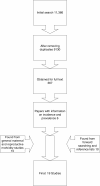Estimating the prevalence of obstetric fistula: a systematic review and meta-analysis
- PMID: 24373152
- PMCID: PMC3937166
- DOI: 10.1186/1471-2393-13-246
Estimating the prevalence of obstetric fistula: a systematic review and meta-analysis
Abstract
Background: Obstetric fistula is a severe condition which has devastating consequences for a woman's life. The estimation of the burden of fistula at the population level has been impaired by the rarity of diagnosis and the lack of rigorous studies. This study was conducted to determine the prevalence and incidence of fistula in low and middle income countries.
Methods: Six databases were searched, involving two separate searches: one on fistula specifically and one on broader maternal and reproductive morbidities. Studies including estimates of incidence and prevalence of fistula at the population level were included. We conducted meta-analyses of prevalence of fistula among women of reproductive age and the incidence of fistula among recently pregnant women.
Results: Nineteen studies were included in this review. The pooled prevalence in population-based studies was 0.29 (95% CI 0.00, 1.07) fistula per 1000 women of reproductive age in all regions. Separated by region we found 1.57 (95% CI 1.16, 2.06) in sub Saharan Africa and South Asia, 1.60 (95% CI 1.16, 2.10) per 1000 women of reproductive age in sub Saharan Africa and 1.20 (95% CI 0.10, 3.54) per 1000 in South Asia. The pooled incidence was 0.09 (95% CI 0.01, 0.25) per 1000 recently pregnant women.
Conclusions: Our study is the most comprehensive study of the burden of fistula to date. Our findings suggest that the prevalence of fistula is lower than previously reported. The low burden of fistula should not detract from their public health importance, however, given the preventability of the condition, and the devastating consequences of fistula.
Figures







Similar articles
-
Debriefing interventions for the prevention of psychological trauma in women following childbirth.Cochrane Database Syst Rev. 2015 Apr 10;2015(4):CD007194. doi: 10.1002/14651858.CD007194.pub2. Cochrane Database Syst Rev. 2015. PMID: 25858181 Free PMC article.
-
Systemic pharmacological treatments for chronic plaque psoriasis: a network meta-analysis.Cochrane Database Syst Rev. 2021 Apr 19;4(4):CD011535. doi: 10.1002/14651858.CD011535.pub4. Cochrane Database Syst Rev. 2021. Update in: Cochrane Database Syst Rev. 2022 May 23;5:CD011535. doi: 10.1002/14651858.CD011535.pub5. PMID: 33871055 Free PMC article. Updated.
-
Maternal and neonatal outcomes of elective induction of labor.Evid Rep Technol Assess (Full Rep). 2009 Mar;(176):1-257. Evid Rep Technol Assess (Full Rep). 2009. PMID: 19408970 Free PMC article.
-
Obstetric fistula in low-resource countries: an under-valued and under-studied problem--systematic review of its incidence, prevalence, and association with stillbirth.BMC Pregnancy Childbirth. 2015 Aug 26;15:193. doi: 10.1186/s12884-015-0592-2. BMC Pregnancy Childbirth. 2015. PMID: 26306705 Free PMC article.
-
Psychosocial interventions for supporting women to stop smoking in pregnancy.Cochrane Database Syst Rev. 2017 Feb 14;2(2):CD001055. doi: 10.1002/14651858.CD001055.pub5. Cochrane Database Syst Rev. 2017. PMID: 28196405 Free PMC article.
Cited by
-
The burden of iatrogenic obstetric fistulas in Sub-Saharan Africa: Systematic review and meta-analysis protocol.PLoS One. 2024 Aug 26;19(8):e0302529. doi: 10.1371/journal.pone.0302529. eCollection 2024. PLoS One. 2024. PMID: 39186485 Free PMC article.
-
Clinical value of endoluminal ultrasonography in the diagnosis of rectovaginal fistula.BMC Med Imaging. 2016 Apr 6;16:29. doi: 10.1186/s12880-016-0131-2. BMC Med Imaging. 2016. PMID: 27053063 Free PMC article.
-
Survival Modeling on the Determinants of Time to Recovery from Obstetric Fistula: The Case of Mekelle Hamlin Fistula Center, Ethiopia.Int J Reprod Med. 2022 Nov 14;2022:8313575. doi: 10.1155/2022/8313575. eCollection 2022. Int J Reprod Med. 2022. PMID: 36419907 Free PMC article.
-
Awareness on obstetric fistula and associated factors among women health development army, in the South Gondar zone, Amhara region, Ethiopia: A cross sectional study.Health Sci Rep. 2024 Oct 14;7(10):e70141. doi: 10.1002/hsr2.70141. eCollection 2024 Oct. Health Sci Rep. 2024. PMID: 39410949 Free PMC article.
-
Barriers and facilitators to preventive interventions for the development of obstetric fistulas among women in sub-Saharan Africa: a systematic review.BMC Pregnancy Childbirth. 2018 May 10;18(1):155. doi: 10.1186/s12884-018-1787-0. BMC Pregnancy Childbirth. 2018. PMID: 29747604 Free PMC article.
References
-
- WHO. Obstetric fistula: guiding principles for clinical management and programme development. Geneva: World Health Organization; 2006. - PubMed
-
- Wall LL, Arrowsmith SD, Briggs ND, Browning A, Lassey A. The obstetric vesicovaginal fistula in the developing world. Obste & gyne survey. 2005;13(7 Suppl 1):S3–S51. - PubMed
Publication types
MeSH terms
LinkOut - more resources
Full Text Sources
Other Literature Sources
Medical

